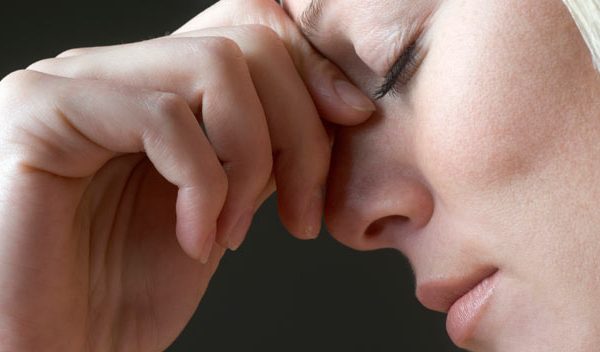For patients struggling with opiate addiction, Suboxone has become a commonly prescribed medication to ease withdrawal symptoms and reduce drug cravings. Suboxone is a combination compound of buprenorphine and naloxone. It is generally prescribed for addicts attempting to quit using illicit opioids like heroin and morphine.
Wonder Drug for Addicts?
Perusing the studies on Suboxone leaves one pondering if this drug is not the wonder drug to help addicts kick the habit once and for all. Doctors who have grave concerns about patients addicted to “harder substances” may look to this medication as a stepping stone to long term treatment options. However, there is a reason Suboxone is classified as a Schedule III narcotic. While there is less potential for abuse, the potential is still there.
Suboxone: How It Works

Abdominal cramps and nausea are common Suboxone withdrawal symptoms.
Suboxone stimulates and binds tightly to the mµ receptors in the brain just as more powerful opioids do. The difference lies in the intensity of the psychoactive effects. Users of Suboxone experience less of a euphoric high. However, because the receptors in the brain are sated, users do not experience severe cravings, which often leads to relapse for opioid abusers. Suboxone also has a ceiling effect, so there are less risks of overdose.
Suboxone Sounds like the Perfect Solution
With reduced euphoria, drug cravings, and chance of overdose, Suboxone seems like the perfect solution for opiate addicts. It is important to consider how the drug works. Buprenorphine binds tightly to the opioid receptors in the brain, which means other more illicit opiates cannot bind effectively. Consider the possibility, however, that the brain becomes more significantly dependent upon this bond than in the dependence developed with illicit opioids.
Other Risks with Suboxone
The studies conducted with Suboxone are clinical in nature, meaning the manner in which the drug is being used is specifically controlled. The problem with drug addicts is that they don’t generally follow rules. Addiction is not only centered on a physical response, but deals in the emotional and behavioral responses of a person, as well. Addicts who want to get high, can abuse Suboxone by crushing it to snort or inject. Patients who turn to illicit use of Suboxone will experience significant withdrawal when attempting to stop.
What Withdrawal Symptoms Can Be Expected?
Opiates work in the pleasure center of the brain. Physical symptoms are harsh when the drug is stopped because messages misfire with an opposite pain response. Physical withdrawal symptoms can include:
- Headaches
- Muscle aches
- Sleeplessness
- Restless Legs
- Chills and sweating
- Flu-like symptoms
- Abdominal cramps, nausea, vomiting and diarrhea
- Tremors and Shakes
What If Suboxone is used as Directed?
For those working to kick an opiate addiction, Suboxone may be a good step on the path to lasting recovery. Opiate addicts experience a high rate of relapse. With every relapse, addicts risk overdose. They also risk contracting other diseases like Hepatitis C and HIV. Medical professionals grappling for ways to best assist addicts in stopping heroin, morphine or oxycodone abuse may discern Suboxone as a solid option to beginning recovery. When addicts are ready to stop all opiates, doctors prescribe a taper schedule to manage Suboxone withdrawal.
How Long Do Withdrawal Symptoms Last?
Coming off Suboxone is incredibly difficult. Depending upon the amount of Suboxone prescribed daily, the taper schedule can take up to one month. The amount of drug is generally decreased by 2-4 mg at a time. A doctor generally follows patients closely during the taper schedule closely to insure withdrawal symptoms don’t become too severe.
Road to Recovery
For patients working toward lasting recovery from all opiates, including Suboxone, commitment and dedication to working with a physician and developing new habits is critical. Living a drug-free life is possible. Changing the mental, emotional and spiritual effects of drug addiction through gradual steps is the best path toward lasting recovery.
For more opiate addiction treatment information or for help finding a rehab program, call us at 800-442-6158 Who Answers? .
Resources
Finch, J., Kamian, J. & Amass, L. (2007). Two-year experience with buprenorphine-naloxone (suboxone) for maintenance treatment of opioid dependence within a private practice setting. Journal of Addiction Medicine. 1(2). 104-110. Retrieved from: http://journals.lww.com/journaladdictionmedicine/Abstract/2007/06000/Two_year_Experience_with_Buprenorphine_naloxone.8.aspx
Jones, H. (2004). Practical considerations for the clinical use of buprenorphine. Addiction Science & Clinical Practice. 2(2). 4-20. Retrieved from: http://www.ncbi.nlm.nih.gov/pmc/articles/PMC2851017/
Ling, W., Hillhouse, M., Domier, C., Doraimani, G., Hunter, J., et. al. (2009). Buprenorphine tapering schedule and illicit opioid use. Addiction. 104(2). 256-265. Retrieved from: https://www.ncbi.nlm.nih.gov/pmc/articles/PMC2851017/









